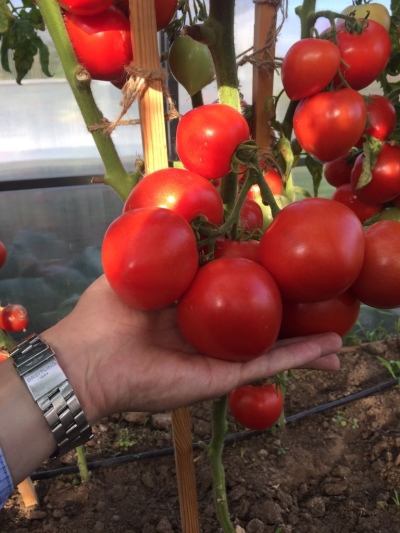
- Authors: Blokin-Mechtalin V.I.
- Year of approval: 2019
- Category: hybrid
- Growth type: determinant
- Appointment: fresh consumption
- Ripening period: early
- Ripening time, days: 90-95
- Growing conditions: for open ground, for film greenhouses
- Transportability: good
- Bush size: medium-sized
Of the huge number of tomatoes known today, early ripening varieties are especially popular and in demand. Any summer resident wants to please himself and his family with ripe, sweet tomatoes, without waiting for the end of the season. It is to such varieties that the Antyufei tomato belongs, which will be discussed below.
Description of the variety
Tomato Antyufei is a large-fruited hybrid, which is a medium-sized determinant plant. The height of the bush varies from 100 to 200 cm. The size depends on the place of planting: in the open field the bush will be smaller than, for example, when grown in a greenhouse.
The bush is quite powerful, but compact. Leaves are of normal type, medium length, the surface of the leaf is slightly corrugated, the color is green. The inflorescence is intermediate, has its own characteristics: the first - above 5-6 leaves, the next after - 1-2 leaves. On the hand there are 4–6 ovaries. The peduncle is articulated.
The variety is characterized by good transportability, keeping quality, heat resistance, crack resistance, stress resistance and high marketability. Purpose - fresh consumption, but also suitable for making juice, pasta, ketchup, adjika. It is inconvenient for canning whole fruits due to its large fruits.
The main qualities of the fruit
A distinctive feature of Antyufei tomatoes is a very beautiful regular shape. Oval and slightly elongated, it ends with a sharp nose. The tomato is quite large: the weight of one fruit is up to 300 g. It is covered with a thin smooth skin, and under it there is a fragrant, dense, but rather tender pulp. Unripe tomatoes are colored light green, and ripe fruit are red without a dark spot at the stalk. The color is even, deep and rich.
Taste characteristics
In the cut, the tomato Antyufei is multi-chamber, fleshy, juicy, with a small amount of seeds. It keeps its shape well, has a bright aroma and sweet taste with a slight sourness.
Ripening and fruiting
Refers to early maturing varieties. Fruiting begins in 3 months (on average 90–95 days) after the first shoots appear. Great for both outdoor and protected cultivation. Ideal for regions with short summers.
Yield
Fruiting amicably, the yield is high, but specific figures depend on the planting site: in the open field - 12-14 kg / m 2, in the protected - 16-18 kg / m 2. From one bush, you can collect up to 5 kg of fruits. One brush weighs on average up to 1.5 kg.
The timing of planting seedlings and planting in the ground
Planting dates depend on the climatic characteristics of a particular region. Usually, sowing seeds for seedlings occurs in March. After the emergence of 2 true leaves on the seedlings, the picking of the seedlings is carried out. Seedlings are planted in open ground when warm weather sets in and the danger of frost has passed.

Growing tomato seedlings is an extremely important process, because it largely depends on whether the gardener can harvest at all. All aspects must be taken into account, from seedbed preparation to planting in the ground.
Landing scheme
Planting density directly depends on where the seedlings will grow. 4 plants are planted in a protected ground per 1 m 2, in an open ground - 5. A dense planting is not encouraged, since there is a risk of decay and fungal attack.

Growing and care
Antyufei is characterized by unpretentious care. The cultivation technique is no different from the cultivation technique of other varieties of tomatoes, but there are nuances that should be kept in mind.
Requires fertile soil and compliance with crop rotation when planting. It is important to organize and moderate watering of tomatoes. This is necessary to prevent root decay. For the same reason, the beds should not be allowed to thicken - if the bushes begin to touch the leaves, the latter should be pruned.
Since the bush grows quite tall, it needs support. On the garden bed, Antyufei is grown as a stake crop. Garter required. The formation of a 3-stem bush will help to increase the yield.
When growing varieties in greenhouses, it is necessary to monitor the humidity of the air and soil in the greenhouse. It should be within the normal range.




A plant needs different micronutrients at each stage of growth. All fertilizers can be divided into two groups: mineral and organic. Folk remedies are often used: iodine, yeast, bird droppings, eggshells.
It is important to observe the rate and period of feeding. This also applies to folk remedies and organic fertilizers.
Disease and pest resistance
Another plus of the Antyufei variety is good immunity. The hybrid is resistant to top rot of fruits, Alternaria, tobacco mosaic virus, phytophthora. This is an important fact, since there is no need to treat the beds with chemicals to combat these diseases. The result is significant savings and an environmentally friendly harvest.


Growing regions
Perfect for growing in the North and North-West, Central, Volga-Vyatka, North Caucasian, Middle Volga, Nizhnevolzhsky, Ural, West Siberian, East Siberian, Far Eastern regions, Central Black Earth Region. The early maturity allows this tomato variety to be successfully grown in regions with short summers, and heat resistance - in the southern regions, where the temperature rises to 35 ° C.

























































































